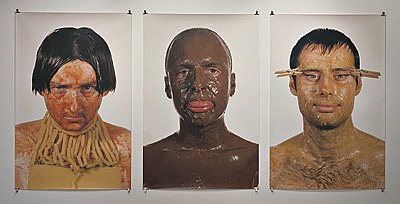| Revista Umělec 2002/1 >> Match Draw | Lista de todas las ediciones | ||||||||||||
|
|||||||||||||
Match DrawRevista Umělec 2002/101.01.2002 David Kulhánek | biennial | en cs |
|||||||||||||
|
"Zvon 2002, the fourth biennial of young contemporary Czech art, has seen the curatorial scepter pass from the project’s original curators, Karel Srp and Olga Mala, to Michal Koleček. Despite taking charge only months before the opening, Koleček never let the inevitable compromises become overtly visible in the show.
Young contemporary Czech art in the show comes off as being nothing “special.” Identifying an image to represent the exhibition was impossible as there was no single theme that stood out (the image of the baby and plunger on the posters and ads is pleasant enough, but ultimately empty). The first two biennials concentrated on a smaller circle of local artists, with selection criteria on a project basis. As a result, the shows, which included many large-scale installations, were presentations of strong concepts and personalities. Michal Koleček chose another approach. The “artists’ potential” is the focus, rather than the “strong artistic positions” represented by ambitious projects. Instead of a display of “finished” works, the curator decided to compile a collection of segments of artwork, with their context, and provide information on a wide range of contemporary production. The loose quality and versatility of the exposition reflect a shift away from the “optimistic” visions of the mid-1990s — toward the disillusionment of a basically depressed contemporary arts scene in the Czech Republic. Although an important show for the entire contemporary art scene, the biennial is mainly a “viewer’s” exhibition aimed at a general audience. Zvon 2002 consists of two exhibition spaces, The House of the Stone Bell, featuring 25 artists and the group Rizoto, and The Golden Ring House, a venue for the forum of independent galleries. When the viewer steps into the House of the Stone Bell he experiences a typical castle tour. Exploring the individual chambers, the speed of information consumption is tolerable but the individual stopovers offer sufficient impulse to move on. For those involved in the contemporary arts scene the “gallery” installation may seem tedious and the sequencing of some of the works somewhat questionable. More participants, a variety of expressive means, more things to see — all this might lead you to expect an exhibition with rhythm. But with the exception of the successful placement of works by Jan Kadlec, Milan Mikuláštík and Tomáš Svoboda, there is no great communication between works. There are no loci on the exhibition map. Larger spaces are provided for some specific projects, the objective being to spread out and realize their full intentions, examples are installations by Pavel Ryška and Lenka Klodová. Some works do stand out. Money Talks, by Jan J. Kotík is the fourth in a series of objects. This unique and politically critical piece is an ATM machine “designed” to make payment cards for young revolutionaries. The work is a living public theme containing many layers. The final three rooms in the exhibition at the Stone Bell represent heterogeneous approaches, confirming that the curatorial decision to “blur” the entire exhibition was relevant and justified. Kamera Skura has managed the nearly impossible — the repeated “joke” in their Benetton parody is still a joke, but they have taken it to a new level. How many takes on Benetton advertisements have been done anyway? Kamera Skura repeated their own idea of food-splattered self-portraits. Objects by Jana Kalinová are playful (a money counter becomes a “projector” of primitive animation) and sexy (a kitchen countertop with faucet and drain becomes a slick mini-golf obstacle) but they also bear a clear social dimension. Complicated, peculiar and utterly sincere, the self-revealing visions of Michal Pěchouček in the film The Usual Hostages close the exhibition. The Forum of Independent Galleries in the House of the Golden Ring focuses on the parallel “periphery” — the neglected potential of alternative spaces for contemporary art. Koleček’s brainchild, the overview is the first of its kind, and hopefully not the last. Maybe it’s a dream, but organizing alternative “art fairs” could theoretically become an established tradition. So what is young Czech art like? It’s position falls within the confines of a dysfunctional gallery system and art market. It is open and loose, unfocused, but is also closed. Lacking a regular “relationship” with what is going on across the borders, it is unable to access the local environment. Capable of being topical, it is local in the positive sense of the word, while maintaining tension between the center and the periphery. It is unfortunate that there are few opportunities to show off its stronger features. A comprehensive package, Zvon 2002 is oriented more towards the audience than to the players in the art scene. Yet art is a “play” acted out not only by actors/artists, curators/screenwriters and gallerists/producers; it is a play for everybody. A point made clear by Krištof Kintera and Jednotka/Unit in the installation they made for Gallery Universal (formerly NoD). An oversized amplifier roars across the room-sized model of a football field as a strangely obtrusive voice monotonously poses questions regarding art and the art system: “Do you like football? Do you like football?” Zvon 2002 comes away with a match result of 1:1 for the tournament (2:0, 0:2). It doesn’t matter who’s playing whom. The goals are anonymous and are the result of standard situations. This is a first league match, not a bad draw. Bowing out is not an option. "
01.01.2002
Artículos recomendados
|
|||||||||||||










Comentarios
Actualmente no hay comentariosAgregar nuevo comentario